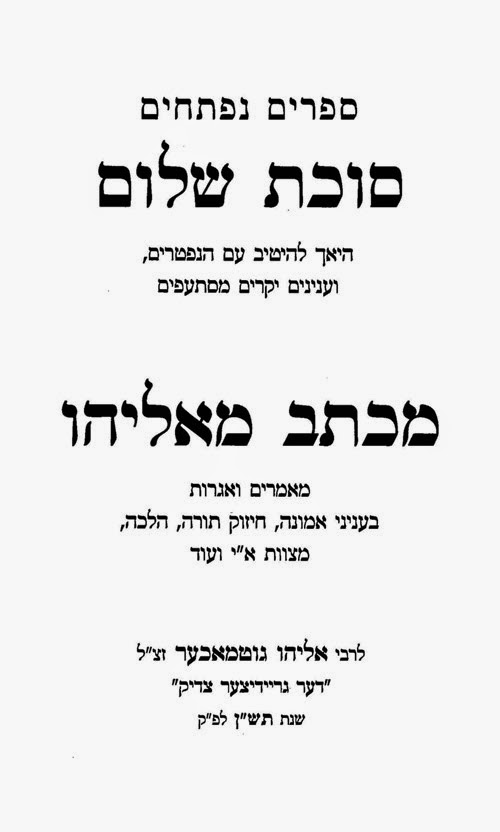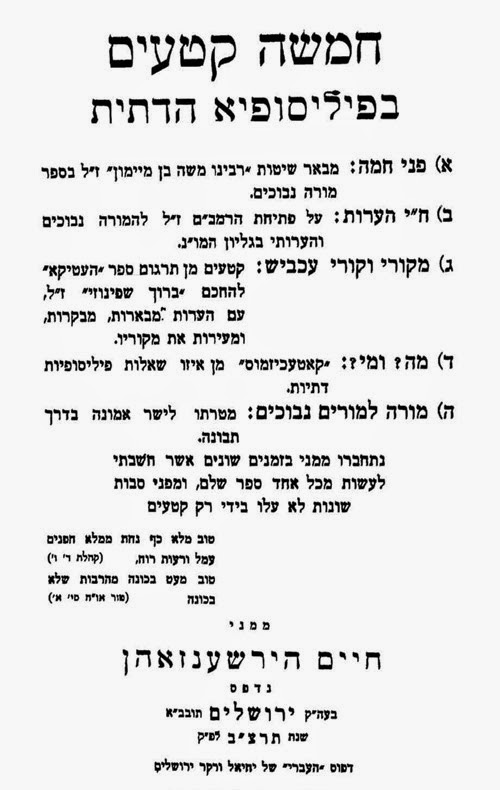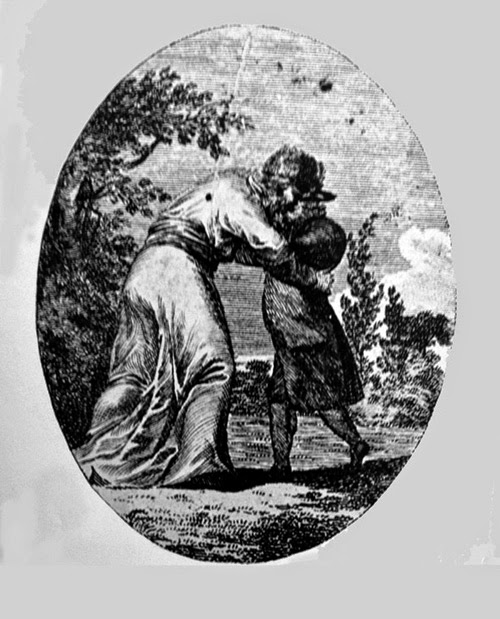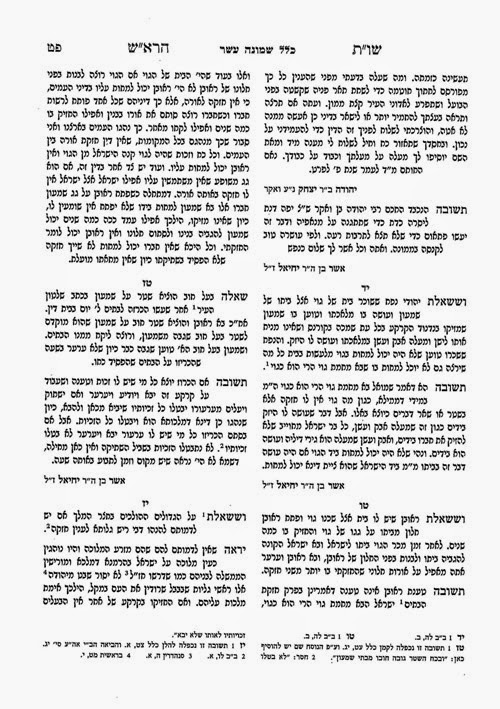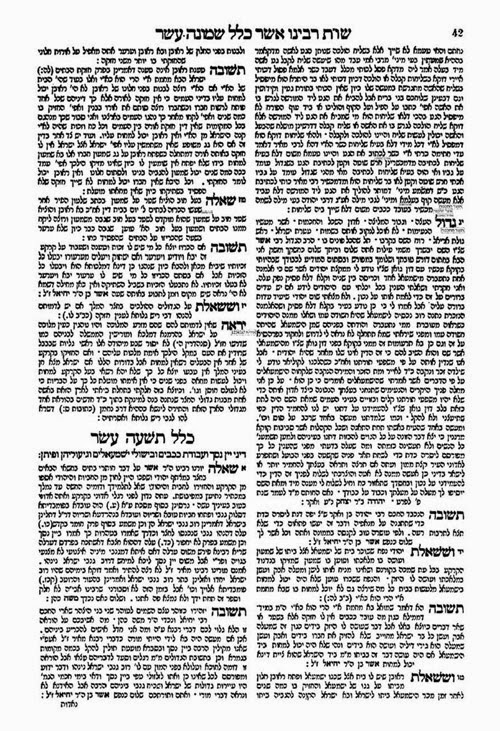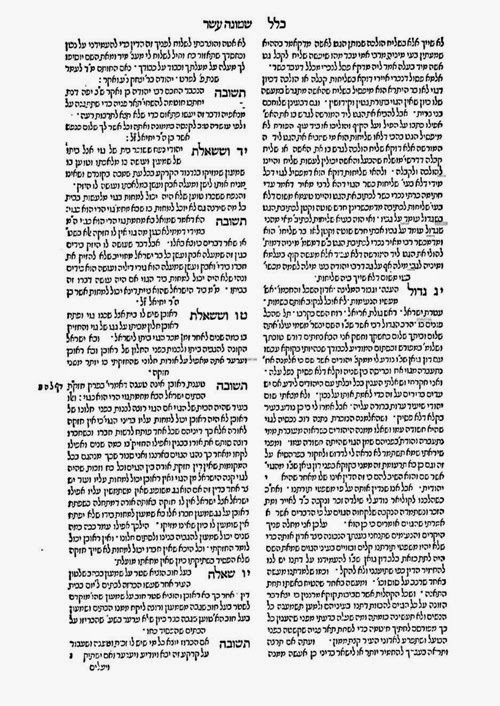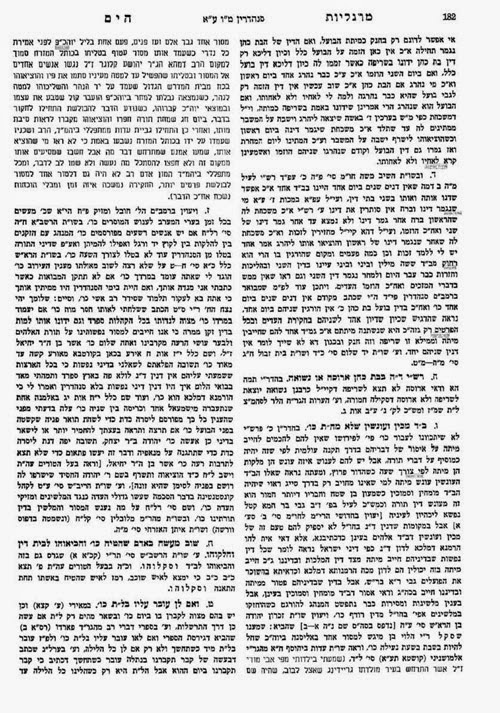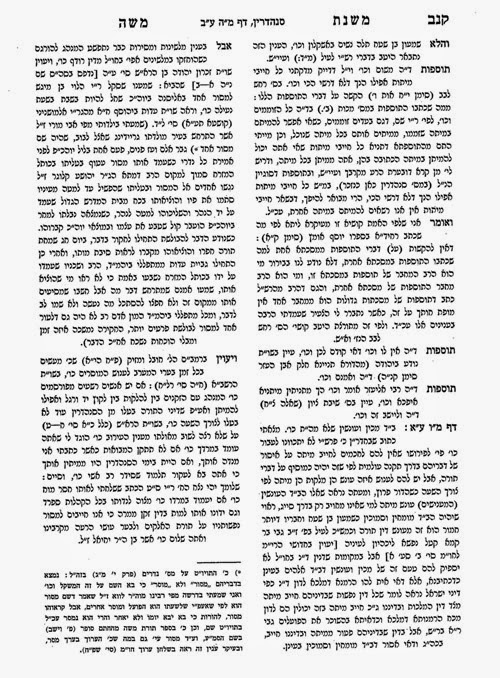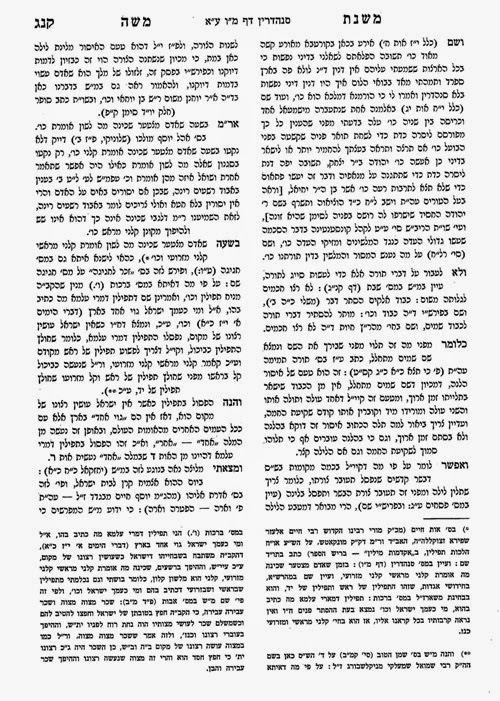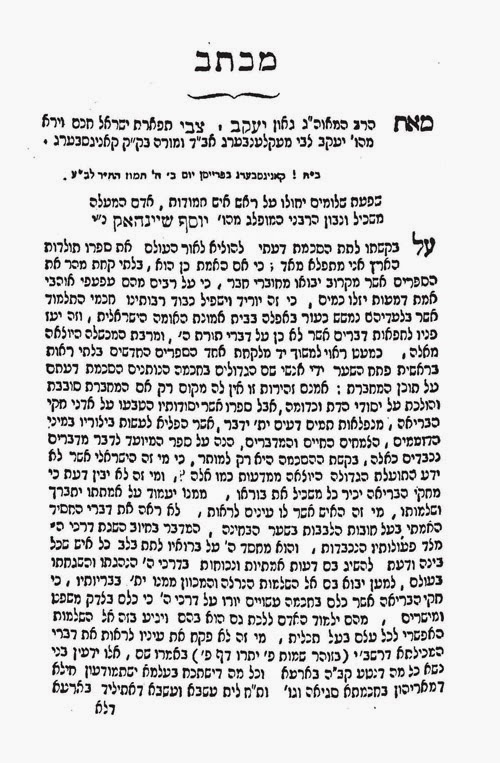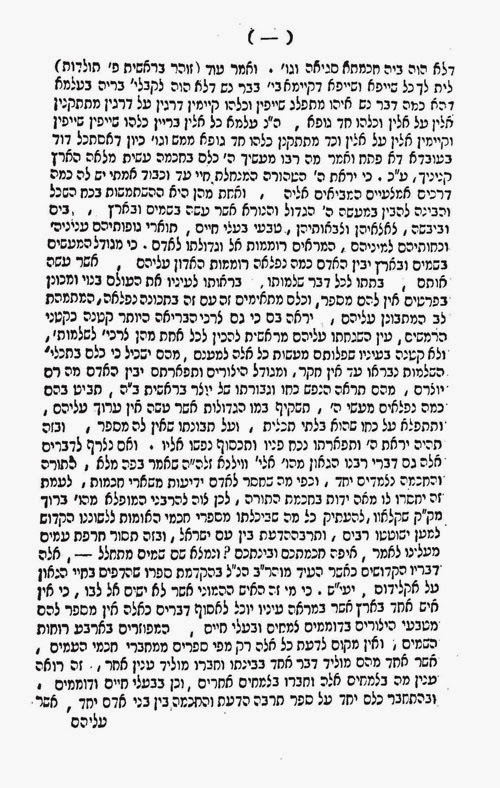Mehalekhet Bi-Darka – A Review Essay
Mehalekhet Bi-Darka – A Review Essay
מלכה פיוטרקובסקי, מהלכה בדרכה: אתגרי החיים במבט הלכתי-ערכי, הוצאת ידיעות אחרונות, תל-אביב תשע”ד, 567 עמ’
Yael Levine
The author holds a Ph.D. from the Talmud department at Bar Ilan University. She is the author of numerous articles related to women in Judaism. She recently published “Tefillot Li-Tevilla”.
The following article is a critical review of the recently published book in Hebrew “Mehalekhet Bi-Darka”, a compilation of articles by Malka Peuterkovsky. The present review focuses on the chapter concerning women and the recitation of kaddish. Several highlights from the Hebrew review will now be mentioned, and the readers are encouraged to read the Hebrew review in its entirety for the full spectrum of comments.
Peuterkovsky attempts to offer a new interpretation of the classic teshuva by the Havvot Yair according to which he didn’t forbid the recitation of kaddish. However, this interpretation is unfounded and is based upon a lack of knowledge of halakhic terminology. She seeks to criticize Rav Bacharach in an unjustifiable manner, and her various discussions concerning this teshuva may be refuted.
Peuterkovsky utilizes a letter written by Henrietta Szold concerning the recitation of kaddish, and refers to this letter in a halakhic context. However, in her letter Szold raised no halakhic reasoning. Peuterkovsky refrained from mentioning that Szold held progressive Jewish beliefs. She was instrumental in the formation of an egalitarian minyan, together with Reform Rabbi Judah Magnes, which shortened the nussah of the tefilla, and omitted mention of the sacrifices.
The author utilizes sources from the responsum of Rabbi David Golinkin on the topic of women reciting kaddish, in its Hebrew version. This influence is particularly evident with regard to “Sefer Ha-Hayyim” which she copies and compounds an inaccuracy found in Golinkin’s work.
In several instances Peuterkovsky quotes excerpts from sources which are misleading. Thus, she quotes short passages in which the poskim express a theoretical position in favor of the recitation of kaddish by women, but refrains from stating that their actual psak is in direct contrast to the notion they mentioned in these quotes. Peuterkovsky erroneously explains the Be’er Heitev. She quotes the work “Ma’ayan Ganim” from the “Torah Temimah”, who himself quoted from a second-hand source which didn’t hand over an exact rendering of the text. She also relies upon the incorrect background information concerning the work and its author taken from Rabbi Baruch Epstein.
The chapter on women and kaddish in Peuterkovsky’s book in replete with mistakes, and can’t be relied upon. The present review also refers to some problematic discussions in the book.
“מהלכה בדרכה” מאת מלכה פיוטרקובסקי – נשים ואמירת קדיש
יעל לוין
מבוא
לאחרונה התפרסם ספרה של מלכה פיוטרקובסקי “מהלכת בדרכה: אתגרי החיים במבט הלכתי-ערכי” בהוצאת ידיעות אחרונות. המאמר הנוכחי מוקדש לעיון בפרק “אמירת קדיש על ידי אישה” בספרה זה (עמ’ 257–295, 539–542). והנה, עיון מעמיק בחומר חושף כי מצויות בעיות מהותיות לאורך הפרק, שאינן מאפשרות להסתמך עליו. אקדים ואומר כי אינני חולקת ברמה המעשית על האפשרות ההלכתית שנשים בזמננו יוכלו לומר קדיש מעזרת הנשים, ויש לכך סימוכין במקורות, כגון בדברי הרב יהודה הרצל הנקין.1 יחד עם זאת, כפי שאפרט, הפרק שכתבה פיוטרקובסקי בנושא נשים ואמירת קדיש בעייתי ביותר מבחינת השימוש במקורות וניתוחם, הוא רצוף שגיאות ולוקה בחסר. לא בדבר אחד או שניים, אלא בשְׁורה של דברים ובעניינים מהותיים. מצב העניינים בכל הנוגע לפרק הנוכחי פוגם באפשרות ללמוד ממנו את הנושא כראוי, וביכולתו להוביל למסקנות שגויות ולטעויות. אסור ולא נכון יהיה לעבור בשתיקה על מצב זה שנוצר, למרות הציפייה הגדולה לכרך שאולי יוכל להיהפך בר-שימוש בציבור הדתי-לאומי, ושמא אף מעבר לכך.
שו”ת חוות יאיר – פרשנות שגויה וניתוח לא ראוי
נתייחס תחילה להערות הנוגעות לניתוח של התשובה בשו”ת חוות יאיר (סימן רכב), שהיא התשובה הראשונה והמרכזית בנושא, לה מקדישה פיוטרקובסקי מקום לא מבוטל. השאלה שהופנתה לרב יאיר חיים בכרך באה על רקע מעשה באמשטרדם באדם שציווה לפני פטירתו שילמדו עשרה אנשים בביתו מדי יום תמורת שכר, ולאחר הלימוד תאמר הבת קדיש, בהעדר בנים. חכמי המקום ופרנסיו לא מיחו בבת. הרב בכרך נשאל לגבי עמדה הלכתית זו. הוא סובר כי קיימת סברה לומר שגם לבת יש שייכות לקדיש. האישה מצווה על קידוש השם וכן גם בבת יש תועלת ונחת רוח לנפש הנפטר באמירת קדיש. למרות זאת, הוא פוסק שיש לאסור על אמירת הקדיש, כלשונו: “ולכן בנדון זה שיש אסיפה ברבים יש למחות”. זאת מחמת שיש לחוש שעל ידי כך ייחלש כוח המנהגים של בני ישראל, וכל אחד יהיה בונה במה לעצמו על פי סברתו, ויבואו לזלזל בדברי חכמים.
במהלך דיונה בתשובת הרב בכרך מציבה פיוטרקובסקי מה שהיא מכנה “כמה קושיות משמעויות” (עמ’ 274). בקושייה הרביעית היא תוהה מדוע מורה הרב בכרך שיש למחות באישה המבקשת לומר קדיש, “ואינו קובע מפורשות שיש לאסור זאת?” (שם). התשובה שהיא מעניקה היא: “משום שאין בכך כל איסור!” (עמ’ 277). אולם אין לקבל את פרשנותה המחודשת הזו, וכוונת פשט דברי החוות יאיר היא שלדידו אמירת קדיש על ידי אישה אסורה. חשוב לדעת כי הטרמינולוגיה ההלכתית הנוגעת לאמירת קדיש אינה מובעת במקורות רק במונחים של איסור והיתר, אלא ביטוי שגור הנוגע להרשאה לומר או שלא לומר קדיש הוא באמצעות הפועל “מחה”. אפשר לציין כדוגמה את הנאמר בחיבורו של רבנו משה מינץ, בן המאה החמש עשרה, שו”ת מהר”ם מינץ: “… אבל היכא דליכא [=היכן שאין] מנהג קבוע על פי חכמים, וליכא שום תקנה קבוע, שעשו בני המדינה או קהילה, פשיטא דאין [=פשוט שאין] מוחין לאבל להתפלל, והמוחה באבל כאלו מוחה באדם מלעשות מצוה” (שו”ת מהר”מ מינץ, מהדורת דומב, חלק ראשון, סימן מג, עמ’ קעו). השימוש בביטוי “יש למחות” בשו”ת חוות יאיר דומה לשימוש בפועל זה בשו”ת מהר”ם מינץ, וההבנה החדשנית שפיוטרקובסקי מבקשת להעניק לעניין אינה נכונה בעליל, והיא נובעת מחוסר הכרתה את הטרמינולוגיה המקובלת. אין להצעתה על מה שתסמוך, ואין לתפוס את דבריו של החוות יאיר במשמעות הרשאה. לכן אין גם לקבל את דבריה אלה: “רב שיפסוק בהתאם להכרעת הרב בכרך, לא יוכל לאסור על אישה לומר קדיש יתומה” (עמ’ 277). היא מקיימת דיון דומה במשמעות דברי הפוסקים הסוברים שיש למחות בנשים מלהניח תפילין (ראו בין היתר עמ’ 138, 144, 148–149), ואף כאן אין לדבריה על מה שיסמוכו.
אחת הקושיות שמעוררת פיוטרקובסקי על החוות יאיר היא שהוא לא הזכיר בתשובתו שאמירת קדיש נחשבת להיות חלק ממצוות כיבוד הורים (עמ’ 270–271). לראיה היא מביאה קטע מדברי הרב פנחס זביחי בשו”ת עטרת פז (חלק א, כרך א, או”ח, ב). אולם יש לתמוה מדוע היא מביאה מוטיב זה מחכם בן זמננו בשעה שמצויים מקורות קדומים הרבה יותר. כך כבר מהר”ם מינץ מזכיר רעיון זה בתשובה שכתב (שו”ת מהר”מ מינץ, מהדורת דומב, חלק שני, סימן פ, עמ’ שפה). כמו כן, רעיון זה מובא משמו של מהר”ם מינץ בתשובה בנושא נשים ואמירת קדיש מאת ר’ אלעזר פלקלס בחיבורו תשובה מאהבה (חלק שני, פראג 1815, ארח חיים, רכט, יו”ד, י ע”א). כך חכם זה כותב “הן אמת שהקדיש הוא מפאת כבוד אב”, עמדה שהוא מזכיר מתוך שו”ת מהר”ם מינץ תוך שהוא מוסיף עליה ומרחיבה. פיוטרקובסקי מביאה במהלך הפרק קטע נבחר בלבד מתוך תשובה מאהבה (עמ’ 280–281), את המשך דבריו שבהם הוא מציין נוהג שראה לפיו בנות קטנות אמרו קדיש בחצר בית הכנסת, אולם הוא אוסר לחלוטין אמירת קדיש על ידי נשים בבית הכנסת עצמו. לגופו של עניין יש לומר כי החוות יאיר לא היה מחויב להזכיר בתשובתו את הרעיון שקדיש קשור למצוות כיבוד הורים, ואין לתמוה עליו כלל בעניין הזה.
פיוטרקובסקי מצטטת )עמ’ 275) את דברי ר’ יצחק מווינה בספרו אור זרוע לפיהם המנהג במקומו, וכן מנהג בני ריינס, הוא שהיתום עומד ואומר קדיש לאחר “אין כא-להינו”. אולם בצרפת נכח שאין מקפידים שהנער האומר הקדיש יהיה דווקא יתום, ונהגו שגם נער שיש לו הורים אומר קדיש. ר’ יצחק מווינה עצמו מעדיף את המנהג הנקוט במקומו. על יסוד זאת קובעת פיוטרקובסקי כי מכיוון שלא היה נוהג ברור, “מכאן שניתן להנהיג שגם יתומות תאמרנה קדיש במניין” (שם) כדי שלא ייגרע חלקן במצוות קידוש שם ה’, וכן כדי שיוכלו לקיים את מצוות כיבוד הורים על ידי עשיית מעשה לעילוי נשמתם. אולם אין מסקנתה זו מוכרחת ומחייבת כלל, ועובדה היא שאין בידינו עדות כלשהי מתקופת הראשונים לגבי אמירת קדיש בידי הבת, כי אם מתקופת האחרונים בלבד. אם כן, היא מכניסה בצורה אנכרוניסטית אלמנט שאין לייחס כלל למנהג המוקדם. הבחנתה זו אינה נחוצה גם משום שיש פוסקים המתירים לנשים לומר קדיש מטעמים אחרים. יש לציין עוד כי בהערת שוליים (עמ’ 540, הערה 10) היא מאזכרת בפרפרזה קטע זה מהאור זרוע, בלא שהיא מפנה לגוף המאמר כאן. ונציין שאין אחידות לאורך הספר בכתיב שמו של האור זרוע (ראו בין היתר עמ’ 127).
יש להזכיר בהקשר לשו”ת חוות יאיר כי פיוטרקובסקי עושה שימוש בנוסח של התשובה שיש בו שגיאות אחדות. כך היא מסתייעת בנוסח התשובה שבפרויקט השו”ת, אולם מצויות שם לפי שעה טעויות שונות בהעתקת הנוסח, המבוסס על הדפוס השני שיצא לאור בלמברג בשנת תרנ”ו. טעויות אלה עומדות להיות מתוקנות בגרסה הבאה של פרויקט השו”ת, בעקבות הערותיה של כותבת שורות אלה. אחת הטעויות הניכרות היא הנוסח “ויבואו לגלגל בו”, במקום “ויבואו לזלזל בו”. טעות נוספת המצויה היא “ונזכר בגמרא” במקום “כנזכר בגמרא”. מתברר שפיוטרקובסקי עשתה שימוש בנוסח שבפרויקט השו”ת, למרות שמוטל היה עליה להוציא מתחת ידה נוסח מבורר. ואמנם היא אינה מציינת את המהדורה של חוות יאיר אשר בה השתמשה. זה לא דבר של מה בכך, אלא עניין עקרוני הקשור לשיטות עבודה בסיסיות; מחבר אמור לעיין בחיבורים עצמם, ולא להסתמך על מאגרים.
יש לציין עוד שהמחברת מתייחסת בדבריה אל “השואלים” (עמ’ 266) שפנו אל הרב בכרך לבירור רשאיות אמירת קדיש בידי הבת במעשה שאירע באמשטרדם, אולם באותה מידה ייתכן שמדובר בשואל יחיד. על פי נוסח דברי הרב בכרך אין אפשרות כלל לקבוע אם מדובר בשואל יחיד או בשואלים רבים. פיוטרקובסקי טורחת להדגיש כי למרות שבעל חוות יאיר מציין שהמקור לאמירת קדיש הוא המעשה בר’ עקיבא, נראה שהמעשה המקורי אירע בר’ יוחנן בן זכאי. היא מביאה מידע זה משמו של מ”ב לרנר במאמרו המחקרי “מעשה התנא והמת” שהתפרסם בכתב העת “אסופות” (מהלכת בדרכה, עמ’ 269; 540, הערה 11), וכן מזכירה תפיסה זו מתוך אנציקלופדיה אוצר ישראל (שם, הערה 12). יש לומר תחילה לגבי אנציקלופדיה זו שהיא יצאה לאור בראשית המאה העשרים, ולא מקובל לעשות בה שימוש בכתיבה אקדמית, אלא יש להסתייע במחקרים ובמקורות ראשוניים יותר. בהקשר זה יש לציין כי המחברת לא עשתה שימוש בחיבור המקיף והנודע של הרב דוד אסף בנושא הנדון, “ספר הקדיש: מקורו, משמעותו ודיניו”, שיצא לאור בשנת תשכ”ו.
כמו כן, מלבד מאמרו של לרנר בעניין “מעשה התנא והמת”, ראה אור לאחרונה מאמרה החשוב של פרופ’ רלה קושלבסקי בנושא זה, “התנא והמת הנודד” ב”אנציקלופדיה של הסיפור היהודי”.2 מחקר זה לא זכה לאזכור אצל פיוטרקובסקי. כמובן שאין להלין על החוות יאיר על שאולי לא עשה שימוש במעשה בריב”ז, אלא החוות יאיר כתב בהתאם למה שניצב לנגד עיניו.
והרי חרף ביקורתה של פיוטרקובסקי כלפי החוות יאיר בעניין זה, היא עצמה מצטטת כמקור לאמירת קדיש את המעשה בר’ עקיבא, כפי שמובא בקובץ אוצר מדרשים, מקור שלגביו היא מודעת שהוא מקור מאוחר, אך היא בוחרת לעשות בו שימוש מחמת שנוסחו נהיר יותר (עמ’ 539, הערה 7). אולם הקובץ אוצר מדרשים איננו מקור שראוי לצטט הימנו, שכן העורך י”ד אייזנשטיין הכניס שינויים כלשהם בנוסחי המדרשים, אלא יש לחזור למקור שממנו ציטט. למעשה היה על פיוטרקובסקי להביא את המקור הטוב ביותר, ואז להציע פרשנות מבארת עליו.
יש להעיר עוד את הדברים הבאים בנוגע לציטוט של פיוטרקובסקי מתוך הקובץ אוצר מדרשים. המחברת מציינת כמראה מקום את המידע הבא: “אוצר המדרשים (איזנשטיין), ניו
יורק, תרע”ה, 1915, עמ’ ת”נ, ד”ה (ל”ב), דבור שביעי” (עמ’ 540, הערה 8). אולם היא לא מזכירה אפילו את שם המדרש הספציפי שממנו נטלה אותו; מדובר במדרש עשרת הדברות. שנית, העמודים שבהם מופיע הקטע המצוטט הם 457–458, ובמהדורת תרע”ה בה עיינתי מספור העמודים הוא במספרים, ולא באותיות כפי שהיא מציינת. (במאמר מוסגר אציין כי הסימון “עמוד ת”נ” מצוי בלקט המקורות על נשים וקדיש שאסף עמיחי טורם, אם כי שאר הרישום הביבליוגרפי אינו מצוי שם). נוסח מדרש עשרת הדברות עצמו מתחיל אמנם בעמ’ 450, אך הקטע המצוטט מופיע בהמשך. בנוסף, מראה המקום המדויק אמור להיות “אות לב, דבור שביעי”, ואין להשתמש כאן במילים “דיבור המתחיל”; זו לא הטרמינולוגיה המתאימה לציטוט המדרש כאן. כמו כן, כותר הספר הוא “אוצר מדרשים”, גם אם בפרויקט השו”ת מופיעה הכותרת בטעות כ”אוצר המדרשים”. מעבר לכך, לפני שנים אחדות יצאה לאור מהדורה מדעית של מדרש עשרת הדברות בההדרתה של ענת שפירא, ובה הייתה פיוטרקובסקי אמורה לעשות שימוש. כך שיש בעייתיות גמורה הן בבחירתה לצטט מדרש מאוחר ככלל, והן בבחירתה לצטט מתוך הקובץ אוצר מדרשים, ולא ממהדורתה של ענת שפירא.
יורק, תרע”ה, 1915, עמ’ ת”נ, ד”ה (ל”ב), דבור שביעי” (עמ’ 540, הערה 8). אולם היא לא מזכירה אפילו את שם המדרש הספציפי שממנו נטלה אותו; מדובר במדרש עשרת הדברות. שנית, העמודים שבהם מופיע הקטע המצוטט הם 457–458, ובמהדורת תרע”ה בה עיינתי מספור העמודים הוא במספרים, ולא באותיות כפי שהיא מציינת. (במאמר מוסגר אציין כי הסימון “עמוד ת”נ” מצוי בלקט המקורות על נשים וקדיש שאסף עמיחי טורם, אם כי שאר הרישום הביבליוגרפי אינו מצוי שם). נוסח מדרש עשרת הדברות עצמו מתחיל אמנם בעמ’ 450, אך הקטע המצוטט מופיע בהמשך. בנוסף, מראה המקום המדויק אמור להיות “אות לב, דבור שביעי”, ואין להשתמש כאן במילים “דיבור המתחיל”; זו לא הטרמינולוגיה המתאימה לציטוט המדרש כאן. כמו כן, כותר הספר הוא “אוצר מדרשים”, גם אם בפרויקט השו”ת מופיעה הכותרת בטעות כ”אוצר המדרשים”. מעבר לכך, לפני שנים אחדות יצאה לאור מהדורה מדעית של מדרש עשרת הדברות בההדרתה של ענת שפירא, ובה הייתה פיוטרקובסקי אמורה לעשות שימוש. כך שיש בעייתיות גמורה הן בבחירתה לצטט מדרש מאוחר ככלל, והן בבחירתה לצטט מתוך הקובץ אוצר מדרשים, ולא ממהדורתה של ענת שפירא.
פיוטרקובסקי מציינת שהמדרש באוצר מדרשים אינו קושר את המעשה בר’ עקיבא לעניין אמירת קדיש, וקישור זה מצוי בספר כל-בו (סימן קיד) (עמ’ 269). אולם מחזור ויטרי (סימן קמד) הוא מקור קדום יותר המעלה זיקה בין המעשה בר’ עקיבא לבין השתקפות קדומה יותר ככל הנראה של אמירת קדיש יתום במוצאי שבתות.
הקושיה הראשונה שפיוטרקובסקי מציבה על החוות יאיר נוגעת למועד תחילת נוהג אמירת קדיש יתום. היא מצטטת תחילה קטע מתוך הערך “קדיש” באנציקלופדיה אוצר ישראל (עמ’ 275), קטע המסכם את ראשית נוהג אמירת קדיש בקהילות ישראל. לפי הנאמר שם, הנוהג לא נהג עד לאחר תקופת הגאונים, וכנראה שהוא התחדש בידי חכמי אשכנז על בסיס האגדה על אודות ר’ עקיבא. והנה, פיוטרקובסקי מעירה בצורה ביקורתית על דברי החוות יאיר שהסתייע באגדה זו, ולא באגדה הראשונית יותר כביכול, ואילו כאן היא לא מבקרת את מה שנכתב באנציקלופדיה אוצר ישראל, אלא היפוכו של דבר, היא בוחרת להסתמך על הנאמר בו.
הקושיה החמישית והאחרונה שפיוטרקובסקי מקשה כלפי החוות יאיר היא: “האם אין חשש שדווקא דחיית שינוי רצוי, שמתאפשר מבחינה הלכתית, יביא לזלזול בחכמי הדור, שאינם משתמשים בכוח שניתן להם על ידי הקב”ה, לקדם את תהליך השינוי המבורך, לעודד אותו ולהביא לקיומו בפועל?” (עמ’ 274). אני סבורה שהפניית שאלה מעין זו אל החוות יאיר כנמען אינה במקום כלל, וניסוח ביקורתי זה כלפי אחד מגדולי הפוסקים איננו ראוי, והוא רשאי לסבור אחרת ממנה. זהו המשך מגמתה לנסות ולערער על אמינותו של החוות יאיר מחמת שהוא אוסר על אמירת קדיש בידי אישה. בין היתר היא מבקשת להראות שלמרות שהחוות יאיר מציין כמקור לאמירת קדיש את המעשה בר’ עקיבא, המעשה המקורי התרחש עם ר’ יוחנן בן זכאי, הגם שהיא גופה עושה שימוש במקור זה. כן היא מציינת במהלך דבריה שהוא אינו מזכיר את המקורות שעליהם הסתמך בקביעתו שיש תועלת באמירת קדיש בידי הבת (עמ’ 269), וכי הוא לא מאזכר את האלמנט שאמירת קדיש היא חלק ממצוות כיבוד הורים. ובעיקר פיוטרקובסקי מבקשת להפוך את האיסור הטמון בפסק ההלכה הברור של החוות יאיר להרשאה לאמירת קדיש בידי הבת, כפי שהראינו בלא בסיס ועוגן.
הנריאטה סולד
מלכה פיוטרקובסקי מביאה לקראת תחילת המאמר על נשים וקדיש מכתב שכתבה הנריאטה סולד (1860–1945) לאחר פטירת אמהּ בקיץ של שנת 1916 לידיד המשפחה חיים פרץ, שהציע לומר עליה קדיש במהלך שנת האבל (עמ’ 260–261). סולד דוחה את דבריו בכותבה שגם לאחר מות אביה ולמרות שהיו לו בנות בלבד, סירבה אמהּ שאדם אחר יאמר קדיש, ובנותיו אמרו זאת. לכן סולד סבורה שרצון האם הוא שבנותיה יאמרו אחריה קדיש. היא כותבת שהמנהג היהודי שגברים אומרים קדיש יקר וקדוש בעיניה. אולם משמעות הקדיש בעבורה היא “שהקרוב שנשאר בחיים, מביע את רצונו וכוונתו בפרהסיא, ובאופן בולט, לקבל על עצמו [את] היחס לקהילה היהודית שהיה להורה שלו וששושלת הקבלה לא תינתק מדור לדור, כאשר כל דור מוסיף את החוליה שלו”.
כאן חובה להצביע על בעיות אחדות הקשורות לשימושה של פיוטרקובסקי במקור זה. קודם כול, חובה היה לציין שהנוסח העברי של המכתב המובא בדבריה אינו תרגום מעשה ידיה, אלא הוא ניטל מתשובה בנושא “אמירת קדיש יתום על ידי נשים” שנכתבה בידי הרב דוד גולינקין, שהוא גם מתרגם הקטע. תשובה זו התפרסמה בנוסח מורחב בספרו “מעמד האשה בהלכה: שאלות ותשובות”, שראה אור בירושלים בשנת תשס”א (עמ’ 123–144). עדותה של הנריאטה סולד מובאת אצל גולינקין לקראת סוף דבריו, ולעומת זאת, פיוטרקובסקי מיקמה את הציטוט לקראת ראש דיונה, ועשתה שימוש מילולי בתרגומו של גולינקין מבלי להזכירו כלל. במקום אחד נשמטה המילה “מאוד” בצירוף “והמנהג היהודי יקר מאוד” וכן היא הוסיפה בסוגריים את המילה “את” שאינה מצויה אצל גולינקין, כמצוטט לעיל. עניין זה מובילנו לעניין המהותי יותר שפיוטרקובסקי עושה שימוש בולט בחומר המצוי בתשובתו הנזכרת של גולינקין במהלך הפרק שכתבה על נשים ואמירת קדיש, למרות שהיא מזכירה אותו בצורה גלויה בהקשר ספציפי אחד בהערת שוליים בודדת (עמ’ 541, הערה 22), וכותר המאמר מועתק מסיבה בלתי ברורה בשינוי. בהמשך נצביע על כך שפיוטרקובסקי נטלה מקורות נוספים ממנו מבלי שעיינה כלל בחיבורים עצמם.
אולם חיוני להעיר תחילה הערות נוספות אחדות לגבי הקטע על סולד ומכתבה הנזכר. נקודה משמעותית היא שעיון בקורות חייה של סולד מעמיד בספק, ולמעשה אינו מאפשר, הסתייעות בדמות זו כמושא חיקוי לעניינים הלכתיים, בוודאי לא לנשים אורתודוקסיות. קודם כול, במכתבה של סולד אין מצויות הנמקות הלכתיות המצדדות באמירת קדיש, מלבד העדות בדבר אמהּ. לכל היותר מצויה כאן כמיהה אישית לומר קדיש, אולם אין בכך די, משום שבדרך כזו של רצון ואיווי – אפשר לבוא חלילה ולבטל הרבה איסורים. עדותה איננה מקור שאפשר להסתייע בו בהקשר הלכתי, ומבחינה זו, מעמדו של קטע זה הוא לגריעותא בהשוואה לעדויות היסטוריות אותנטיות אחדות שיש בידינו בדבר בנות קטנות שאמרו קדיש. ויש בידינו עדויות אחדות על נשים שחפצו לומר קדיש, כגון בשו”ת יד יצחק לרב אברהם יצחק גליק (חלק ג, יורה דעה, סימן שמ), המוזכר בהמשך הפרק באופן חלקי בידי פיוטרקובסקי (עמ’ 280).
סולד החזיקה בדעות ליברליות ומתקדמות. אביה הרב בנימין סולד, היה רב בקהילה רפורמית, ויחד עם זאת, שמר שבת כהלכתה. עם זאת, היו לו מחלוקות בנושאים מסוימים הן עם רבנים אורתודוקסים וכן עם רבנים רפורמים מסוימים. הוא נפטר בשנת 1902, וכאמור בנותיו אמרו אחריו קדיש.
הנריאטה סולד הביעה באיגרת משנת 1897 את עמדתה האישית המסורתית-החיובית בעניין פטורן של נשים ממצוות עשה שהזמן גרמן. אולם בהמשך עברה מטמורפוזה אישית בחשיבתה הדתית. בראשית המאה העשרים בחרה ללמוד בבית המדרש לרבנים הקונסרווטיבי בניו יורק. היא האישה הראשונה שהתקבלה למוסד זה לאחר שהובהר לה שלא תוכל לקבל הסכמה לרבנות. לפי מקורות כתובים היא אמנם שמרה שבת, אולם בהמשך דרכה, במאמר שראה אור בשנת 1923 תיארה את היותה שותפה לייסוד מניין שיוויוני, שבין מייסדיו נמנה גם יהודה מאגנס (1877–1948), שהיה רב רפורמי. במניין זה קוצר נוסח התפילה והוצאו ממנו קטעי התפילה המזכירים הקרבת קרבנות.3 אם כן, דמות זו ומאווייה הדתיים, ובין היתר העובדה שלא ראתה פסול במניין שאין בו מחיצה ובשינוי נוסח התפילה, אינם אמורים להוות מושא חיקוי עבור נשים אורתודוקסיות. ההסתמכות על סולד כדמות הראויה לחיקוי מתאימה אולי לציבור הקונסרווטיבי, אך במפורש לא לציבור האורתודוקסי.
במקום אחר במהלך הפרק על נשים ואמירת קדיש פיוטרקובסקי עושה שימוש בדעתה של סולד כ”תנא דמסייע”. כך במהלך דיונה על הנחיצות שקדיש ייאמר בידי צאצאי הנפטר עצמו, בין זכרים בין נקבות, היא מסתייעת בדעתה של סולד: “… ברור שאין זה משנה אם הצאצא המזכה את אביו… הוא בנו או בתו… כפי שטענה הנריאטה סאלד במכתב שצוטט בתחילת הפרק” (עמ’ 270). ואגב יוער, שקודם לכן הכתיב של שם משפחתה הוא “סולד”, ואם כן ניכר חוסר אחידות לאורך הפרק.
הסתייעות במקורות חלקיים וקטועים
כאמור, אפשר להצביע על כך שפיוטרקובסקי עשתה שימוש מובהק בתשובתו של הרב דוד גולינקין על נשים ואמירת קדיש. דבר זה בולט באופן מיוחד במה שנוגע לציטוטים של קטעי מקורות אשר זהים לאלה שגולינקין עצמו הביא, זאת באופן שכמוהו היא מצרפת אותן מילות הסבר בתוככי המקורות עצמם.
תופעה זו בולטת באורח מיוחד במקור מחיבורו של ר’ שמעון פרנקפורטר, בן זמנו של הרב יאיר חיים בכרך, ספר החיים (אמשטרדם תס”ג, סימן נ, מט ע”א), שממנו מביאה פיוטרקובסקי ציטוט קצר: “כי אין לבת בקדיש, לא דין ולא דת, ואין זה אלא ‘שטות חסידי’, כי הוא כחוכא וטלולא!” (מהלכת בדרכה, עמ’ 277–278). ציטוט זהה מצוי אצל גולינקין (עמ’ 128). אפשר להראות בבירור שהמחברת העתיקה קטע זה ממנו, דבר הניכר בטעות משותפת. במקור כתוב: “שטות חסידי'” – דהיינו “שטות חסידים” – וכך היה צריך לכתוב זאת. בספר החיים עצמו מובאות לאחר המילים הללו התיבות “אף שיש לו לשון למודים”, אולם הן נעדרות מגולינקין ומפיוטרקובסקי כאחד. בנוסף, במקור כתוב “כחוכה” ואילו אצל גולינקין ואצל המחברת כתוב “כחוכא”. מבחינה זו, למרות שגולינקין מצביע על הדפוס הראשון כמקור לשאיבתו, נוסח הטקסט עצמו אינו זהה לגמרי למצוי שם. אולם לענייננו חשוב שמלכה פיוטרקובסקי העתיקה ככל הנראה את הקטע ישירות מגולינקין, ולא עיינה בספר עצמו, ספר שמהדורתו הראשונה אמנם נדירה ביותר.
שימושים נוספים במקורות המצויים אצל גולינקין ניכרים לגבי החיבורים הבאים: מטה אפרים, שדי חמד, תשובה מאהבה ויד יצחק. העובדה שהציטוט ממטה אפרים לר’ אפרים מרגליות (דיני קדיש יתום, ד, ח) נטולה מגולינקין ניכרת בהערה זהה המצויה בפנים הקטע (מהלכת בדרכה, עמ’ 278; גוליניקין, עמ’ 129). מקור נוסף שהמחברת מזכירה הוא משל ר’ חיים חזקיה מדיני בספרו שדי חמד (אסיפת דינים, מערכת אבילות, אות קס), האוסר על נשים לומר קדיש (מהלכת בדרכה, עמ’ 278–279). השאיבה הישירה המובהקת מגולינקין (עמ’ 127) ניכרת בהבאת אותן שתי הערות מבארות המצויות אצלו בסוגריים. המקרה התרחש באחד “מהקרימצאקים”. אין הסבר למונח זה בשדה חמד עצמו, וגולינקין מעניק בסוגריים את מילות הביאור “מיושבי קרים”, וכך בדיוק עושה פיוטרקובסקי. כמו כן, גולינקין עורך שינוי לקראת סיום הקטע, תוספת אות בסוגריים להבהרה, “וזה [ב]כלל ‘שב ואל תעשה עדיף'”, ושינוי זה מובא אצל פיוטרקובסקי אף היא. גם בנוגע לציטוט מתוך שו”ת תשובה מאהבה לר’ אלעזר פלקלס מדובר בציטוט של אותו הקטע עצמו וכן בהכללת אותן שתי הערות מבארות לטקסט (מהלכת בדרכה, עמ’ 280–281; גולינקין, עמ’ 133). לתשובה זו התייחסנו לעיל בהקשר לרעיון הקושר בין אמירת קדיש יתום לבין כיבוד הורים.
פיוטרקובסקי מביאה ציטוט בן שורה מתוך שו”ת יד יצחק לרב אברהם יצחק גליק (ג, יו”ד, סימן שמ), וזהו אותו ציטוט המצוי אצל גולינקין. “הנה, אם נלך אחר עיקר הדין, נראה לי דיותר טוב שתאמר הבת קדיש מבן הבת” (מהלכת בדרכה, עמ’ 280; גולינקין, עמ’ 132). חשוב להזכיר שהרב גליק פוסק אחרת באופן מעשי, על בסיס החוות יאיר ופוסקים נוספים. הוא סבור שבן הבת יכול לומר קדיש, אולם טוב תעשה הבת אם תשכיר בן תורה שילמד משניות לעילוי נשמת הנפטר. לפנינו דוגמה שבה פיוטרקובסקי התעלמה מהפסק המעשי של המחבר.
תופעה עקרונית ובעייתית זו של אי-איזכור הפסיקה המעשית של הפוסק במקומות שקיים פער בין עיקרון מכיל ומתיר יותר בהשוואה לפסק מחמיר יותר, בולטת במקומות נוספים במהלך הפרק שכתבה פיוטרקובסקי על נשים וקדיש. נציין תחילה את הדוגמה המובהקת הקשורה לרב חיים דוד הלוי. מלכה פיוטרקובסקי מביאה כפתיח לפרק על נשים ואמירת קדיש קטע מתשובה של רב זה (עשה לך רב, ה, סימן לג), קטע שמופיע ביתר הרחבה במאמר עצמו. וזה נוסח הקטע המלא המובא בספר: “ולמה ייראו דברי חכמים כחוכא ואיטלולא, אם תאמר הבת קדיש במניין שבבית? ולמה קשה להסביר שגם בתו היא יוצאת חלציו, וכשמקדשת שם שמים במניין שבבית – עושה נחת רוח לנשמת הוריה, ממש כמו אמירת קדיש ע”י הבן” (מהלכת בדרכה, עמ’ 291). מדברים אלה משתמע לכאורה שהרב ח”ד הלוי מתיר אמירת קדיש לאישה באופן גורף. אולם החומר מובא כאן בצורה קטועה. בפועל מדובר בתשובה רחבת היקף של הרב ח”ד הלוי, שבה הוא מסייג את דבריו בקטע המצוטט, ומציב תנאים מפורשים לאמירת קדיש בידי אישה. כך הוא אינו מתיר אמירת קדיש בבית הכנסת מהטעם של חשש להרהורי עבירה אצל הגברים, ומטעם זה עצמו אוסר אמירת קדיש בבית הקברות. הוא מתיר אמירת קדיש במניין שבבית, אולם רק בקרב חוג המשפחה, “ולא בשעה שבאים רבים להתפלל בצבור כנהוג בבתי-אבלים”. אולם פיוטרקובסקי לא מצאה לנכון להזכיר ולהביא מידע חיוני זה, וכך מצטייר הרושם המוטעה והמסולף כאילו הוא מתיר לגמרי אמירת קדיש בידי נשים. אם כן, פיוטרקובסקי העלימה מידע חיוני מהקורא, שכן הקטע המצוטט על ידה הוא דיון עקרוני, ואינו משקף את הפסיקה הלכה למעשה, וקיים מרחק עצום בין השתקפות הדיון בדעתו של הרב חיים דוד הלוי בדבריה של פיוטרקובסקי לבין דבריו הממשיים במלואם. למעשה, קטע זה שפיוטרקובסקי מצטטת הוא שמובא אצל גולינקין (עמ’ 132). אלא שיש בידינו חוברת מקורות שערכה פיוטרקובסקי בשנת תש”ס, “עיון בשו”תים: לקט מקורות”, הכוללת את הנושא של אמירת קדיש בידי נשים, ומשם נראה שהיא הכירה חלקים רחבים יותר של התשובה.
וכאן אנו מגיעים לתשובתו של הרב עובדיה יוסף (כפי שמופיעה באתר האינטרנט “הלכה יומית”; מהלכת בדרכה, עמ’ 291–292). מתברר שדעתו קרובה במידה מרובה לדעתו של הרב ח”ד הלוי, ולגביו פיוטרקובסקי מביאה את כל הסייגים שהוא מעמיד. הרב עובדיה מתיר אמירת קדיש רק לאישה שאין לה אחים, וזאת במניין שבבית, לאמירת דברי תורה, או לאחר קריאת תהלים באיזה מקום שיהיה. אולם אין לאישה לומר קדיש באולם המרכזי של בית הכנסת.
פיוטרקובסקי מביאה את עצם דעתו של הרב ח”ד הלוי על רקע אזכור העובדה שרבני עדות המזרח אוסרים אמירת קדיש בידי נשים, ובכללם השדי חמד והרב עוזיאל. כנגדם ציינה שהרב ח”ד הלוי מתיר אמירת קדיש לנשים. אולם כאמור, היא לא מזכירה את התנאים שהוא מציב, ומבחינה זו אפשר לומר שפסיקתו זהה לזו של החוות יאיר, השקפה שהיא כה מתאמצת במהלך ניתוח תשובתו לבטל.
בהקשר לדברינו יש לומר כי פוסקים מועטים התייחסו לשאלת אמירת קדיש על ידי נשים בבית הקברות. קדם לרב חיים דוד הלוי הרב אליעזר סילבר (1882–1968) בארה”ב שמתיר את אמירתו,4 ואילו הרב חיים דוד הלוי אוסר זאת. אי-איזכור דבריו המפורשים של הרב ח”ד הלוי בנוגע לנשים ואמירת קדיש, בין היתר בבית הקברות, צורמת גם על רקע המסגרת הכללית של הפרק, של אישה שפנתה למחברת על מנת לזכות בחוות דעת בעניין אמירת קדיש בהלוויית אביה בבית הקברות.
הבאה חלקית נוספת של תשובה אשר ראוי היה לאזכר את תוכנה במלואה נוגעת לרב משה פיינשטיין. מלכה פיוטרקובסקי מזכירה את הידרשותו של הרב פיינשטיין לאמירת קדיש בידי נשים בתשובה שנושאה: “אם צריך מחיצה לחוץ (לחצוץ – י”ל) רק בפני מעט נשים” (או”ח, ה, סימן יב) (עמ’ 286). היא מביאה ציטוט מתוך תשובה זו שבה הוא מאזכר אגב אורחא את התופעה שלעיתים נהגו נשים להיכנס לעזרת הגברים לומר קדיש: “… והנה בכל הדורות נהגו שלפעמים היתה נכנסת אשה ענייה לבית המדרש לקבל צדקה, או אבלה לומר קדיש…” (שם). בהמשך היא כותבת שהרב פיינשטיין מתאר את נוהג הנשים להיכנס לבית הכנסת ואינו מעיר דבר לגביו (עמ’ 288). אולם היא נמנעת מלציין את התנאי המפורש שהוא מתווה של הימצאות אישה בודדת או שתי נשים בלבד כמציאות שאינה מחייבת הקמת מחיצה לצורך תפילה. אם כן, מתברר שהמחברת הזכירה את הנושא במקוטע, והשמיטה פרט מהותי להבנת הנושא לפיו אי-העמדת מחיצה תלויה בהימצאות של אישה אחת ולכל היותר של שתי נשים, וכי אין היתר גורף לכניסת קבוצה גדולה יותר של נשים לעזרת הגברים לאמירת קדיש.
נקודה הראויה לציון קשורה לדבריו של הרב אליעזר זלמן גראיעווסקי בחיבורו קדיש לעלם, שבו הוא מגלה דעה המתירה לנשים לומר קדיש. פיוטרקובסקי מצטטת קטע מדבריו, שבו המחבר מטעים שאין נפקא מינה אם היתום הוא בן או בת (מהלכת בדרכה, עמ’ 281). יחד עם זאת, נפרסת כאן תמונה חלקית בלבד שכן הרב גראיעווסקי עצמו מוסר שהוא הראה את דבריו לרב שלמה אהרן ורטהיימר, רב וחוקר יהדות נודע והמגלה הראשון של הגניזה הקהירית. הרב ורטהיימר חלק עליו בנקודות מסוימות, ודבריו מתפרסמים בהמשך ספר קדיש לעלם עצמו. אולם כל זה איננו מוזכר אצל פיוטרקובסקי, ויש כאן הצגת תמונה חלקית בלבד. ראוי גם להצביע על בעיה טכנית בקטע הזה, שכן המילים “נפקא מינה” מובאות בתרגום עברי אך רק בהופעתן השנייה, ולא הראשונה. במקרה הזה אפשר להעלות את ההשערה שפיוטרקובסקי נטלה את הקטע המצוטט מתוך אוסף המקורות בנושא אמירת קדיש בידי נשים בעריכתו של עמיחי טורם, שם מובא קטע זהה ממש, וכן מצויה זהות ברישום הביבליוגרפי.
שגיאה בהבנת הבאר היטב, זלדה והתורה תמימה
אחד המקורות שמביאה פיוטרקובסקי המתירים אמירת קדיש לאישה במניין שבבית הוא דברי באר היטב לר’ יהודה אשכנזי על השולחן ערוך, ובהם נאמר: “וכל שכן לבת, אין לה קדיש כלל בבית הכנסת, ואם רוצים לעשות לה מניין – רשות בידם” (או”ח, קלב, ה; עמ’ 280). המחברת מקדימה קטע זה בכותבה שהבאר היטב פוסק כמו הרב יעקב ריישר (שבות יעקב, ב, יו”ד, סימן צג; שם, עמ’ 279–280). חכם זה התיר לילדה בת ארבע לומר קדיש במניין שבבית. אולם דבריה אלה של פיוטרקובסקי אינם נכונים בעליל. היא לא זיהתה שהקטע שהיא מצטטת הוא למעשה סיכום דעתו של בעל כנסת יחזקאל (יו”ד, נג ע”א), כמו שנזכר שם מפורשות מעט קודם לכן, ומכאן שאין מדובר בדעתו האישית והעצמאית של הבאר היטב. את דעתו של הכנסת יחזקאל מזכירה פיוטרקובסקי עצמה שני עמודים קודם לכן (עמ’ 278).
בהקשר זה חשוב לציין שניכר הבדל בין דברי הכנסת יחזקאל עצמו לבין הדברים המובאים משמו בבאר היטב. בעל כנסת יחזקאל סובר שאין לבן הבת, וכל שכן לבת, קדיש כלל בבית הכנסת, אולם במניין נפרד הרשות נתונה לבן הבת או למי שרוצה לומר קדיש בגין המת, אך לנקבה כלל לא. לעומת זאת, מהנאמר בבאר היטב משתמע שאין לבת קדיש בבית הכנסת, אולם “אם רוצים לעשות לה מניין – רשות בידם”. נראה שיש ליישב את הסתירה לכאורה בין המקורות בהבנה שהמילה “לה” היא למעשה קיצור של המילה “להם”, והייתה אמורה להופיע עם גרש. כלומר שהרשות בידי בן הבת או בידי מי שרוצה לומר קדיש במניין לעשות כן, והבאר היטב קיצר ולא הזכיר כלל אישה בהקשר למניין בבית. מכל מקום, הדברים המוזכרים אצל פיוטרקובסקי בעניין באר היטב אינם נכונים ומטעים, ואין אפשרות להסתמך עליהם.
פיוטרקובסקי מביאה את העדות הנוגעת לאמירת קדיש על ידי המשוררת זלדה (עמ’ 287). המשפחה עלתה ארצה בשנת 1925, כשזלדה הייתה בת אחת עשרה, וזמן לא רב לאחר מכן נפטרו סבה, בערב חנוכה תרפ”ו (1925), ואביה – כחלוף שישה שבועות. היא, כבת יחידה, אמרה קדיש מדי יום בבית הכנסת. פיוטרקובסקי מציינת כמקור לדבריה את ספרה של אסתר אטינגר “זלדה: שושנה צחורה”, שיצא לאור בשנת 2007. פיוטרקובסקי מסתייעת בספרה של אטינגר גם בפרק השישי של “מהלכת בדרכה” (עמ’ 222, 535). אולם חיבור זה הוא ספר פופולרי, ולמעשה, המקור הישיר שעליו נשענת אטינגר בעניין אמירת קדיש על ידי זלדה הוא מחקרה המוקדם יותר של פרופ’ חמוטל בר-יוסף, “על שירת זלדה” (מהדורה מורחבת, תל-אביב 2006, עמ’ 14), ואותו היה ראוי לאזכר. בר-יוסף מגוללת שם שזלדה ואמהּ גרו באותה העת בשכונת שערי חסד, וזלדה קיבלה רשות לומר קדיש בבית הכנסת הג’ורג’י, דהיינו הגרוזיני, כלומר הקדיש לא נאמר בבית כנסת אשכנזי. נקודה זו היא בעלת חשיבות על רקע העדות המעשית שמביאה פיוטרקובסקי (עמ’ 287) בשם יעקב יהושע ולפיה הנוהג של אמירת קדיש בידי בנות קטנות היה קיים בבתי הכנסת של האשכנזים בירושלים, אך לא בבתי הכנסת של הספרדים. אולם זלדה כן אמרה קדיש בבית הכנסת הגרוזיני.
לקראת סיום המאמר מביאה פיוטרקובסקי את התשובה שהשיב ר’ שמואל הרקוולטי ב”שו”ת מעין גנים” (עמ’ 295) על אישה שחפצה ללמוד תורה, וזאת במצוטט מ”תורה תמימה” (לדברים יא, ט, אות מח): “אמנם הנשים אשר נדב לבן אותנה לקרבה אל המלאכה – מלאכת ה’, מצד בחירתן בטוב במה שהוא טוב, הנה הן תעלינה בהר ה’ תשכונה במקום קודשו, כי נשי מופת הנה, ועל חכמי דורן לאדרן, להדרן, לסדרן, לחזק ידיהן, לאמץ זרועותיהן וכו’, עשי והצליחי ומן השמיים יסייעוך”. אולם ניכרות כאן בעיות אחדות. החיבור מעין גנים איננו ספר הלכתי, אלא הוא נמנה עם הסוגה של אגרונים, ומדובר במכתב פיקטיבי שכמובן לא נשלח מעולם, ולפיכך אין לפנינו תשובה הלכתית, גם אם יש מי שטעה לחשוב אחרת. כמו כן, הקטע המצוטט בתורה תמימה איננו הנוסח המקורי, ויש בו כמה שינויים בהשוואה למקור, וכבר הראה הרב יהושע מונדשיין5 שבעל תורה תמימה העתיק את הקטע הנדון לא מכלי ראשון כי אם מכלי שני, מגיליון כתב העת “הצפירה” משנת תרנ”ו, שהביא קטע זה. בנוסף, ב”מהלכת בדרכה” הוכנסו שינויים נוספים שכן הטקסט מובא בכתיב מלא, למרות שאין לשנות מנוסחם של ציטוטים. כן יש להזכיר שאותו הקטע עצמו מצוטט ביתר הרחבה, מתוך ספר תורה תמימה אף הוא, בספרה הנדון של פיוטרקובסקי בפרק על נשים ותלמוד תורה (עמ’ 75).
עוד יש לציין כי ביחידה על המחברים הקרויה “פרשנים ופוסקים שהוזכרו בספר” כותבת פיוטרקובסקי שר’ ברוך הלוי אפשטיין הנו מחברו של ספר מקור ברוך על הירושלמי (עמ’
505). אולם חיבורו זה איננו על הירושלמי. ראוי להזכיר כי במקור ברוך עצמו מופיע ציטוט מקביל מתוך ספר מעין גנים. העולה מתוך דברינו הוא כי מלכה פיוטרקובסקי הסתמכה בצורה עיוורת על דברי בעל תורה תמימה, ולא מצאה לנכון לבדוק את ספר מעין גנים בפנים, או לעיין בחומר רקע נוסף על החיבור. וכך יוצא שפיוטרקובסקי פרסמה מידע שגוי. גם אם מחבר תורה תמימה פרסם דברים בלתי נכונים, מוטל היה על המחברת לבדוק את הקטע מכלי ראשון, וכן להביא מידע אמין על החיבור.
505). אולם חיבורו זה איננו על הירושלמי. ראוי להזכיר כי במקור ברוך עצמו מופיע ציטוט מקביל מתוך ספר מעין גנים. העולה מתוך דברינו הוא כי מלכה פיוטרקובסקי הסתמכה בצורה עיוורת על דברי בעל תורה תמימה, ולא מצאה לנכון לבדוק את ספר מעין גנים בפנים, או לעיין בחומר רקע נוסף על החיבור. וכך יוצא שפיוטרקובסקי פרסמה מידע שגוי. גם אם מחבר תורה תמימה פרסם דברים בלתי נכונים, מוטל היה על המחברת לבדוק את הקטע מכלי ראשון, וכן להביא מידע אמין על החיבור.
סיכום
הפרק על נשים ואמירת קדיש שהוציאה מתחת ידה מלכה פיוטרקובסקי לוקה בחסר, הוא בעייתי מבחינת תהליך השימוש במקורות, ויש בו שגיאות לא מעטות. מהפרק הזה עולה ומצטיירת תמונה בלתי מהימנה, ואין אפשרות להסתמך עליו.
המחברת מעניקה פרשנות מחודשת כביכול לשו”ת חוות יאיר ולפיה המחבר אינו אוסר על אמירת קדיש בידי נשים, אולם פרשנות זו, המנוגדת לכל סברה הגיונית, אינה נכונה והיא נובעת מחוסר היכרות עם הטרמינולוגיה ההלכתית בנושא, ועל כן היא נדחית מאליה. השקפתה של המחברת היא כי מכיוון שלא היה בתחילת הנהגת מנהג אמירת קדיש יתום נוהג ברור, ויש עדויות לפיהן הן יתומים והן קטנים שלא היו יתומים אמרו קדיש, דבר זה מאפשר אמירת קדיש בידי נשים. אולם אין יסוד להבנה זו, ובתקופת הראשונים אין כלל עדויות מעשיות או דיונים עקרוניים בדבר אמירת קדיש בידי נשים. גם אם אפשר להסב את המעשה בר’ יוחנן בן זכאי או בר’ עקיבא על בת, אין ליצור אנכרוניזם כזה. כך ששני החידושים הללו שאותם ביקשה לחדש, אין להם על מה שיסמוכו.
פעמים רבות המחברת מביאה ציטוטים חלקיים של מקורות באופן שנוצר רושם שגוי ביחס לדעתם של הפוסקים. כך בעוד שמהקטע המצוטט עולה לכאורה שהם סוברים שאמירת קדיש מותרת, באופן מעשי מהמשך המקורות עולה שחכמים אלה אוסרים אמירת קדיש בידי נשים אושהם מציבים תנאים לאמירתה, ואילו הקטעים המצוטטים בידי פיוטרקובסקי מתייחסים לעיקרוןתיאורטי בלבד שהם עצמם דוחים הלכה למעשה. כך הם פני הדברים בנוגע לדברי הרב אברהםיצחק גליק, הרב חיים דוד הלוי והרב משה פיינשטיין. חלק מהציטוטים החלקיים הללו
נטולים מהתשובה בעניין אמירת קדיש בידי נשים שנכתבה על ידי הרב דוד גולינקין, דברשבולט באמצעות המקור מתוך ספר החיים שפיוטרקובסקי נטלה ממנו כלשונו באופן שהיא שיכפלה טעות המצויה אצלו. כחלק מההשפעה של גולינקין על תשובתה מצטטת פיוטרקובסקיכלשונו קטע ממכתב שכתבה הנריאטה סולד, שתרגומו ניטל מגולינקין, וזאת מבלי להזכירוכלל. פיוטרקובסקי מעלה על נס את דמותה של סולד שחפצה לומר קדיש, למרות שהנימוקיםשהעלתה אינם מבוססים על מקורות הלכתיים ולמרות שהמחברת לא הציגה בפני הקוראים את עולמה הדתי ואת העובדה שהיא החזיקה בדעות מתקדמות. דיונה של המחברת בקטע בבאר היטבשגוי. ראוי אף להזכיר שהמחברת מפנה לספרו של גולינקין בהערת שוליים בפרק “נשים כפוסקות הלכה” (עמ’ 524–525, הערה 35), אל הפרק אשר דן בעניין זה ואשר נושא אותו הכותר עצמו.
נטולים מהתשובה בעניין אמירת קדיש בידי נשים שנכתבה על ידי הרב דוד גולינקין, דברשבולט באמצעות המקור מתוך ספר החיים שפיוטרקובסקי נטלה ממנו כלשונו באופן שהיא שיכפלה טעות המצויה אצלו. כחלק מההשפעה של גולינקין על תשובתה מצטטת פיוטרקובסקיכלשונו קטע ממכתב שכתבה הנריאטה סולד, שתרגומו ניטל מגולינקין, וזאת מבלי להזכירוכלל. פיוטרקובסקי מעלה על נס את דמותה של סולד שחפצה לומר קדיש, למרות שהנימוקיםשהעלתה אינם מבוססים על מקורות הלכתיים ולמרות שהמחברת לא הציגה בפני הקוראים את עולמה הדתי ואת העובדה שהיא החזיקה בדעות מתקדמות. דיונה של המחברת בקטע בבאר היטבשגוי. ראוי אף להזכיר שהמחברת מפנה לספרו של גולינקין בהערת שוליים בפרק “נשים כפוסקות הלכה” (עמ’ 524–525, הערה 35), אל הפרק אשר דן בעניין זה ואשר נושא אותו הכותר עצמו.
פיוטרקובסקי עשתה שימוש בחיבורים פופולריים שאין ראוי לעשות בהם שימוש, כגון באנציקלופדיה אוצר ישראל ובקובץ אוצר מדרשים, וזאת במקום לחזור למקורות ראשיים או לאזכר מקורות מוסמכים יותר. כן העתיקה מקורות מכלי שני שנוסחם שגוי, כגון העתקת הקטע ממעין גנים מתוך תורה תמימה, וכן נוסח השו”ת המרכזי בעניין נשים ואמירת קדיש, שו”ת חוות יאיר, התפרסם בנוסח משובש שהועתק מפרויקט השו”ת, מבלי שהיא אימתה את הנוסח עם מהדורה מודפסת. במקרים רבים היא לא ציינה את מהדורות הספרים שבהם עשתה שימוש.
הפרסום של הוצאת ידיעות אחרונות הנוגע לספר “מהלכת בדרכה” אומר בין היתר ש”הוא ספר פורץ דרך הניצב בשורה אחת עם ספרי ההלכה של דורנו”, והפרק על אמירת קדיש בידי נשים מוזכר כדוגמה לכך. אולם כגודל הציפייה לפרסום ראוי, כך גודל האכזבה. לו הייתה לומדת לקראת לימודי דוקטוראט ממשיים הייתה רוכשת לעצמה כלים לכתיבה תורנית, והדברים הללו לא היו מתרחשים.
המסגרת החיצונית של הפרק על נשים וקדיש ב”מהלכת בדרכה” לא מוסיפה לרצינותו. נקודת המוצא של הפרק היא מקרה של אישה חילונית שהתקשרה טלפונית אל המחברת, והעמודים הראשונים מתארים שיחות ביניהן, וכן מהלך הפרק נקטע חליפות ועניינה של אישה זו עולה שוב. אולם כל החומר הזה – לא היה ראוי להביאו כלל, והדברים נראים פופולריים יתר על המידה. אף פוסק אינו נוהג כן, אלא מקובל להציג את השאלה ואת רקעה לכל היותר בקטעים אחדים. עצם שימת הדגש על הוצאת פסק הלכה שונה לאישה חילונית ולאישה דתית, או אולי העלאת הנמקות שונות לזו ולזו, צורמת.
במבוא ל”מהלכת בדרכה” מעניקה פיוטרקובסקי קרדיט לכמה בני אדם. אולם אין זה משנה את המציאות המרה כפי שתיארתי במאמר זה, והאחריות הישירה והאישית למצב מונחת
על הכותבת. החומר לא עבר ביקורת מספקת, ואם לכאורה עבר ביקורת, יש דברים שנשמטו מידיהם של אותם קוראים. זו גם אזלת ידה של השיטה האומרת כי כשמדובר בפרסום פופולרי אין צורך לדקדק כל כך.
על הכותבת. החומר לא עבר ביקורת מספקת, ואם לכאורה עבר ביקורת, יש דברים שנשמטו מידיהם של אותם קוראים. זו גם אזלת ידה של השיטה האומרת כי כשמדובר בפרסום פופולרי אין צורך לדקדק כל כך.
עיוננו זה מתייחס בעיקרו של דבר לפרק על נשים ואמירת קדיש. יש צורך לקיים עיונים מעמיקים מקבילים ביחס ליתרת החומר. אולם כבר ניכר לעין שהבעייתיות אינה מצטמצמת לפרק על נשים ואמירת קדיש וכי מצויה בעייתיות כלשהי בפרק על נשים ותלמוד תורה. כאמור, אף בפרק זה היא מצטטת מתוך התורה תמימה, ולא מתוך ספר מעין גנים. נציין עתה הערות אחדות נוספות.
פרק ט’ ב”מהלכת בדרכה” דן בנושא של חובת ההימנעות ממצב או מקום סכנה, מול מסירות נפש בקיום מצוות. פיוטרקובסקי מציינת בהערת שוליים (עמ’ 249, הערה 10) את המעשה ברב כהנא שעסק במכירת סלים (קידושין מ ע”א). פעם תבעה אותו מטרוניתא לדבר עבֵרה, וכדי שלא להיכשל בבעילת נוכריה – עלה לגג וקפץ ממנו. אליהו הנביא הגיע ממרחק ארבע מאות פרסה כדי לתופסו שלא ייפול וימות, ונזף בו על שהטריחו. פיוטרקובסקי מבקשת ללמוד מכאן “שאסור (ההדגשה במקור – י”ל) היה לו לסכן את חייו כדי להימנע מלעבור עבירה”. אולם אין לקבל בשום אופן פרשנות זו שממנה עולה שמוטב היה לו לרב כהנא לחטוא מאשר להטריח את אליהו הנביא, יש לדחות הסבר זה מכל וכול, ואין ללמוד מכאן היתר כלשהו לאדם לעבור עבֵרה בתנאים כלשהם. אלא הכוונה היא שאליהו נזף ברב כהנא על שבחר מלכתחילה בעיסוק שבמסגרתו הוא נאלץ לבוא במגע עם נשים, והוא לא שעה להוראה במשנת קידושין (ד, יד) “לא ילמד אדם את בנו אומנות שבין הנשים”.6
במהלך הפרק הדן בתפילה על החולה, המחברת עוסקת בנושא של היענות ה’ לתפילות, ומביאה את המקור הנוגע לתפילתה של חנה: “‘והיה כי הרבתה להתפלל’ – מכאן שכל המרבה בתפלה – נענה” (עמ’ 230). אולם מקור זה מובא מתוך ילקוט שמעוני (שמואל א, רמז עח), שהוא מקור משני, ולא מתוך המקור הראשי שהוא מדרש שמואל (מהדורת ליפשיץ א, ט, עמ’ 10). קטע זה במדרש שמואל עצמו מיוסד על הירושלמי בברכות (פ”ד ה”א, ז ע”ב), בתענית (פ”ד ה”א, סז ע”ג) ובביכורים (פ”ב ה”א, סד ע”ג). בנוסף, מובעת שם דעה הפוכה המפקפקת ביעילותה של תפילה מרובה, ועמדה זו אינה מוזכרת כלל.
יצויין עוד כי במהלך הפרק הנוגע להנחת תפילין על ידי נשים, פיוטרקובסקי דנה במקורות התנאיים והאמוראיים, אך אינה מסתייעת במקבילה לברייתא במסכת תפילין (הלכה ג, מהדורת היגער עמ’ מב-מג), אחת משבע מסכתות קטנות.
בפרק על נשים כפוסקות הלכה דנה המחברת בשני חידושי התורה של הרבנית בילה פאלק (עמ’ 91–97). החידוש הראשון נוגע לעיתוי של אמירת ברכת ההדלקה על נרות יום טוב. בדומה לנוהגן של הנשים בהדלקת נר שבת, מנהגן ביום טוב היה להדליק את הנרות תחילה ולאחר מכן לברך. אולם הרבנית סברה כי ראוי שהנשים יאמרו את ברכת ההדלקה על הנרות ביום טוב קודם ההדלקה עצמה, משום שלא כמו בשבת, אין ההדלקה אסורה ביום זה.
שיטתה של הרבנית בילה התקבלה אמנם בקרב פוסקים רבים, ובכלל זה ה”משנה ברורה” (רסג, כז) והרב עובדיה יוסף (יחוה דעת, א, כז; ב, לג). לעומת זאת, יש שפסקו כמו ה”מגן אברהם”, כגון ה”מטה אפרים” (תרכה, לג; ואלף למטה שם, אות מט) וה”קיצור שולחן ערוך” (עה, ד). אולם חיוני להזכיר כי במקורות שונים בספרות הראשונים מובעת מפורשות הדעה שבין בשבת בין ביום טוב יש לברך על הדלקת הנר עובר לעשייתה. כך ב”ארחות חיים” לר’ אהרן הכהן מלוניל (נפטר בשנת צ’ לערך; 1330 לערך) נאמר כי אחד האיש ואחד האישה מברכים תחילה ואחר כך מדליקים, וכן הוא הדין ביום טוב (דין הדלקת הנר בע”ש, אות א, עמ’ צז). וכך מוזכר גם בחיבורו האחר ספר כל בו (לא). בנוסף, דעה זו מובעת בין היתר ב”ספר המנהגים לרבינו אייזיק טירנא” (מהדורת שפיצר, עמ’ מ). מקורות אלה מספרות הראשונים אינם מוזכרים בדבריה של פיוטרקובסקי או במקורות הביבליוגרפיים שבהם עשתה שימוש (עמ’ 525, הערה 38).
והנה, לא מסתבר שנשי ישראל נהגו לאורך הדורות במנהגים כה בולטים בצורה שגויה מבלי שדמות תורנית תמצא לנכון לערער עליהם. אלא צריך לומר שמנהג הנשים להדליק נרות ביום טוב עובר לעשייתן מסתמך על מקורות סמכותיים מספרות הראשונים, והרבנית העלתה טעם מחודש. משום כך הטרמינולוגיה “מנהג טעות” אינה המושג הראוי והמתאים לשימוש בנוגע לנוהגן זה של הנשים.
באשר לחידוש השני של הרבנית בילה, שהוא הצעתה שביום טוב ידליקו הנשים נרות מבעוד מועד ולא לאחר ערבית, פיוטרקובסקי מציינת שלא התעוררו לגביו חילוקי דעות (עמ’ 93). אולם אין דברים אלה נכונים בעליל ויש מגדולי ישראל שחלקו על ההשקפה הזו. גם כאן, המקורות שבהם מסתייעת המחברת לא הזכירו את הדעות החולקות על חידוש התורה השני שלה. ואין כאן המקום להאריך ולפרט.7
בפרק הנדון על “נשים כפוסקות הלכה” מאריכה המחברת מאוד את הדיבור על הנשים בתקופת הרב יהודה עייאש מתוך מאמר בכתב העת פעמים מאת פרופ’ צבי זוהר, ובה בעת היא לא מזכירה כלל את המאמר החשוב המובא באותו כתב העת מאת ד”ר אורי מלמד ופרופ’ רינה לוין-מלמד על הרבנית אסנת בראזני שהקדישה את עיתותיה ללימוד תורה ועמדה בראש ישיבה. כל זאת באופן שהחומר איננו אחיד.
הערות
* מאמר זה נכתב ברובו המכריע סמוך להוצאתו לאור של “מהלכת בדרכה”. תקציר ממנו, בבחינת הקדמה לנושא, פורסם ביום שישי, כ”ד באלול תשע”ד, 19 בספטמבר 2014, באתר כיפה בלינק הבא: http://www.kipa.co.il/tarbut/177/58796.html. נוסח כמעט זהה פורסם באתר ערוץ 7 במוצאי שבת, כ”ה באלול תשע”ד, 20 בספטמבר 2014, והוא נמצא בלינק הבא: http://www.inn.co.il/News/News.aspx/284259. המאמר הנוכחי ארוך בהרבה מן התקציר, וכולל חומר רב נוסף שלא מוזכר בו. המאמר הנוכחי עודכן במקומות אחדים מני כתיבתו הראשונית. פרסום המאמר פרי עטי הצית את הפולמוס סביב ספרה של פיוטרקובסקי. והנה, בגיליון ערב סוכות של עיתון “בשבע” התפרסם מאמרו הביקורתי של הרב יואל קטן “אין הלכה כמותה” על “מהלכת בדרכה” (בשבע, י”ג בתשרי תשע”ה, 7 באוקטובר 2014, גיליון 614, עמ’ 60, 62). לפי דברי הרב קטן, בשעה שכתב את מאמרו לא היה מודע להימצאות מאמרי. מאמרו של הרב קטן עורר פולמוס אף הוא. מלכה פיוטרקובסקי עצמה הפיצה ביום שישי, ט”ז בתשרי תשע”ה, 9 באוקטובר 2014, מסמך-מאמר ובו ביקשה לדחות את דבריו, וביום ראשון שלאחר מכן, י”ח בתשרי, 11 באוקטובר, השיב הרב יואל קטן במסמך תגובה משל עצמו שהופץ. “הבהרה” קצרה מאת הרב קטן התפרסמה בגיליון הבא של “בשבע” (כ”ט בתשרי תשע”ה, 23 באוקטובר 2014, גיליון 615, עמ’ 24), וכן נדפס באותו העמוד המאמר “ביקורת מגדרית” מאת יועצת ההלכה שולמית בן שעיה. דיון ער סביב מאמרו של הרב קטן, גם על רקע הביקורת הראשונה מאת כותבת שורות אלה, התפתח בבמות שונות, בין היתר בפורום הבא הנמצא באתר “אוצר החכמה”: http://forum.otzar.org/forums/viewtopic.php?f=7&t=19808&sid=621100864cffdfdd13d22f520f84382b אני מוצאת לנכון לציין כי לאורך המאמר הנוכחי אני מכנה את מחברת “מהלכת בדרכה” בשמה כפי שמופיע בספר עצמו, בלא תוספת כינוי. כידוע יש מחלוקת בציבור הרחב בנוגע לשאלה אם יש להצמיד לה תארים נלווים, כגון “הרבנית” או “אשת ההלכה”. כאמור, אני עושה שימוש בשמה כפי שמופיע בספר עצמו.
1. ראו בין היתר, הרב יהודה הרצל הנקין, “אמירת קדיש על ידי אשה וצרוף למנין מעזרת
נשים”, הדרום, נד (תשמ”ה), עמ’ 34–48; הנ”ל, שו”ת בני בנים, ב,
ז; ג, כז; Rabbi Yehuda Henkin, “Women and Kaddish”, Equality Lost: Essays in Torah
Commentary, Halacha, and Jewish Thought, Jerusalem 1999, pp. 42–49; “Women,
Kaddish, and the Halakhic Process”, pp. 50–53.
וראו לאחרונה יגיל הנקין, “הקדיש הוא לא הסיפור”, מקור ראשון, מוסף שבת,
י”ד במרחשוון תשע”ה, 7 בנובמבר 2014, גיליון 900, עמ’ 6, 9; יעל לוין,
“לא היה הראשון”, מקור ראשון, מוסף שבת, תגובות, כ”א במרחשוון
תשע”ה, 14 בנובמבר 2014, גיליון 901, עמ’ 18.
נשים”, הדרום, נד (תשמ”ה), עמ’ 34–48; הנ”ל, שו”ת בני בנים, ב,
ז; ג, כז; Rabbi Yehuda Henkin, “Women and Kaddish”, Equality Lost: Essays in Torah
Commentary, Halacha, and Jewish Thought, Jerusalem 1999, pp. 42–49; “Women,
Kaddish, and the Halakhic Process”, pp. 50–53.
וראו לאחרונה יגיל הנקין, “הקדיש הוא לא הסיפור”, מקור ראשון, מוסף שבת,
י”ד במרחשוון תשע”ה, 7 בנובמבר 2014, גיליון 900, עמ’ 6, 9; יעל לוין,
“לא היה הראשון”, מקור ראשון, מוסף שבת, תגובות, כ”א במרחשוון
תשע”ה, 14 בנובמבר 2014, גיליון 901, עמ’ 18.
2. רלה קושלבסקי, “התנא והמת הנודד”, אנציקלופדיה של
הסיפור היהודי: סיפור עוקב סיפור, בעריכת יואב אלשטיין ואחרים, רמת-גן תשס”ה,
עמ’ 281–296. ייחוס המעשה לר’ יוחנן בן זכאי מצוי בין היתר בקטע גניזה
(לרנר, אספות, ב, עמ’ סט) וב”פרקי דרך ארץ”, בתוך: נספחים לסדר אליהו
זוטא, מהדורת איש שלום, ב, עמ’ 22–23.
הסיפור היהודי: סיפור עוקב סיפור, בעריכת יואב אלשטיין ואחרים, רמת-גן תשס”ה,
עמ’ 281–296. ייחוס המעשה לר’ יוחנן בן זכאי מצוי בין היתר בקטע גניזה
(לרנר, אספות, ב, עמ’ סט) וב”פרקי דרך ארץ”, בתוך: נספחים לסדר אליהו
זוטא, מהדורת איש שלום, ב, עמ’ 22–23.
3. Baila Round Shargel, Love Lost: The Untold Story of Henrietta Szold, Philadelphia , 1997, pp. 331–333, 377
4. ראו יעל לוין, “נשים ואמירת קדיש ב’שו”ת אינטרנט'”, עמודים 678 2–3 (חשוון-כסלו
תשס”ד), עמ’ 18–23. יש לציין שמאמר זה אינו מצטמצם להתייחסויות לנושא
באינטרנט בלבד, והוא מביא חומר רב על נשים ואמירת קדיש.
תשס”ד), עמ’ 18–23. יש לציין שמאמר זה אינו מצטמצם להתייחסויות לנושא
באינטרנט בלבד, והוא מביא חומר רב על נשים ואמירת קדיש.
5. הרב יהושע מונדשיין, “מקור ברוך – מקור הכזבים”,
6. וראו בהרחבה אברהם וולפיש, “העריכה היוצרת וכוח היצר: עיון בעריכת מסכת קידושין במשנה,
בתוספתא ובבבלי”, JSIJ 7 (2008), עמ’ 31–79.
בתוספתא ובבבלי”, JSIJ 7 (2008), עמ’ 31–79.
7. וראו אף יעל
לוין, “עיונים בעקבות הספר ‘תיקו'”, אתר כיפה, כ”ט בתשרי
תשע”ה, 23 באוקטובר 2014, http://www.kipa.co.il/tarbut/177/59191.html.
לוין, “עיונים בעקבות הספר ‘תיקו'”, אתר כיפה, כ”ט בתשרי
תשע”ה, 23 באוקטובר 2014, http://www.kipa.co.il/tarbut/177/59191.html.
—
© כל הזכויות
שמורות ליעל לוין 2014
שמורות ליעל לוין 2014

